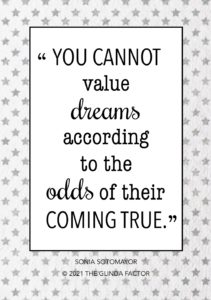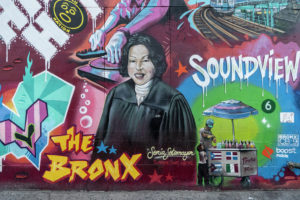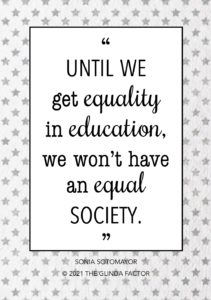
Passionate Patriot
She was born to Puerto Rican parents and grew up in the housing projects of South Bronx. Life wasn’t easy for her as a child, and her solace was Nancy Drew books and Perry Mason television shows. Before long, she dreamt of becoming a lawyer and judge. She never lost sight of that childhood dream and overcame every obstacle she encountered, from conquering her fear of public speaking to learning how to study. After years of hard work, her dream finally came true when she was nominated to become a federal district court judge. Step into the hallowed halls of the US Senate Chamber in 1992 and watch the confirmation hearings of Sonia Sotomayor…
Her Ruby Shoe Moment
The Power of the Wand
Her Yellow Brick Road
Brains, Heart & Courage
Glinda’s Gallery
Just the Facts
Her Ruby Shoe Moment
Sonia Sotomayor looked at the thick stack of papers in her hands. She just completed the most important employment application of her life. It was 1990, and she was applying for the position of federal district court judge. And she was only 36 years old.
A few weeks earlier, a partner at her law firm had learned that Sonia’s name was being floated as a possible candidate for an open position on the District Court for the Southern District of New York. Pat Moynihan represented New York in the US Senate. His judicial selection committee was looking for qualified Hispanic candidates and they were willing to consider her.

“The Four Justices,” by Nelson Shanks (National Portrait Gallery)
The partners at Sonia’s law firm supported her nomination whole-heartedly. In fact, they offered an extra assistant and paralegal to help her with the paperwork. She had to provide all her financial information, professional experience and countless names and addresses of people she has interacted with during her adult life, both personally and professionally. The application seemed endless and took about one week to complete.
After her application was submitted, Senator Moynihan’s office called to schedule an interview with his judicial selection committee. She had 2 weeks to prepare for the biggest interview of her life. She and her colleagues tried to anticipate the questions that may be asked, as well as concerns the committee may have about her candidacy (such as her age).
Sonia sat down in front of 15 members of Moynihan’s judicial selection committee. She was peppered with questions for hours — the extent of her trial experience, her familiarity with various legal strategies, areas in which she lacked experience and how she would address it, her community service, and how she would learn to think like a judge.
Then, Sonia traveled to Washington DC to meet with Senator Moynihan in person. After talking for about a hour, the Senator offered to nominate her as a district court judge in New York. But first, he asked if she was willing to spend the rest of her professional life on the bench. Her answer was an immediate and unqualified YES!
 Senator Moynihan put Sonia’s name forward for nomination and President George HW Bush reluctantly accepted it. The confirmation process took more than 18 months. And it wasn’t easy. She had two interviews with members of the Justice Department, was the subject of multiple investigations by different agencies, and appeared before the Senate for a conformation hearing.
Senator Moynihan put Sonia’s name forward for nomination and President George HW Bush reluctantly accepted it. The confirmation process took more than 18 months. And it wasn’t easy. She had two interviews with members of the Justice Department, was the subject of multiple investigations by different agencies, and appeared before the Senate for a conformation hearing.
In the meantime, people from all aspects of Sonia’s life stepped forward to support her nomination — colleagues from the District Attorney’s office, the Hispanic National Bar Association, lawyers she had worked with over the years, the partners at her law firm, and colleagues from the nonprofit organizations in which she was involved. Sonia was surprised and humbled at the outpouring of support.
Finally, the US Senate confirmed her nomination to the District Court for the Southern District of New York on August 12, 1992. It was a dream come true and she embraced the next phase of her career with gusto. Six years later, she was nominated to the Second Circuit Court of Appeals. While serving on the Second Circuit, Sonia heard more than 3,000 appeal cases and wrote over 350 opinions. After 12 years on the Second Circuit, Sonia was nominated to the US Supreme Court. She was appointed in 2009 and finally realized her childhood dream.
The Power of the Wand
Sonia Sotomayor became the first Hispanic and the third woman to serve on the highest court in our nation. She is proud of her Puerto Rican heritage and candid about the obstacles she had to overcome as a first generation college student. In fact, her leadership and service inspired a group of Princeton University alumni to establish The Sonia Sotomayor 1976 Scholarship Fund, which provides scholarships to first generation students who “demonstrate a commitment to service.”
Her Yellow Brick Road
Sonia started at the US District Attorney’s Office in New York City on 1979. She tried her first case only a few weeks after she started and her boss allowed her the latitude to follow her instincts. She combined her Ivy League education with her experiences growing up in the Bronx to become particularly effective in the courtroom.

“Sonia Sotomayor,” by Timothy Greenfield-Sanders (National Portrait Gallery)
While working as a federal prosecutor, Sonia joined the board of directors of the Puerto Rican Legal Defense and Education Fund (PRLDE). She was the youngest board member at the time and served for 12 years. Sonia’s experience at PRLDE helped her learn how to navigate the politics of an organization, as well as balance the needs of an individual against the greater good of a community.
Over time, Sonia’s work at the US District Attorney’s Office began to wear on her. She was constantly surrounded by criminals and eventually felt some of her optimism and faith in human nature erode away — it was time to move on. Sonia did some research and noticed that many judges had a combination of government and corporate experience. So she decided it was time to join a private law firm and practice corporate law.
Sonia joined Pavia & Harcourt, a small law firm that specialized in representing European businesses in America. It had 30 lawyers and 2 of its 9 partners were women. She started as a first year associate in 1984 and worked her way up the ladder. She proved herself quickly and gained experience with contracts, arbitration, commercial litigation, and intellectual property. In fact, she helped clients such as Fendi enforce their trademarks by tracking down and suing vendors and manufacturers of imitation products. Sonia made partner within 4 years.
Brains, Heart & Courage
Sonia grew up with her younger brother in the public housing projects of the Bronx. Her parents were both from Puerto Rico and spoke little English. Her father was an alcoholic and her mother dealt with it by working night shifts at the hospital. So Sonia had to be self-reliant at an early age and often stepped up to care for her younger brother. She also spent a lot of time with her grandma, who was her safe haven.

“Portrait of Sonia Sotomayor in a 2015 mural celebrating The Bronx,” by Camilo J. Vergara (Library of Congress)
Sonia was diagnosed with Type I Juvenile Diabetes when she was 8 years old. Back then, the disease was managed with hospitalization, multiple blood draws per day, and insulin shots. Sonia learned to manage it by monitoring how she felt constantly and giving herself insulin shots.
After Sonia’s dad died when she was 9 years old, her mom made more of an effort to speak English at home. Sonia’s English improved quickly and school became easier. In addition, she fell in love with books, started to watch Perry Mason on television, and decided that she wanted to be a judge when she grew up. She needed to work hard, learn how to study, and continue to improve her English.
Sonia attended Cardinal Spellman High School and looked for every chance to improve herself. She participated in student government and the debate team and it paid off — she won first place at a speech competition when she was a junior. Sonia graduated valedictorian of her class, then followed her friend’s advice and applied to a number of Ivy League schools (without understanding how elite they were). She was offered a full scholarship to Princeton and took it.
 Life at Princeton was a big adjustment — Sonia was insecure, homesick, and experienced culture shock. But she rose to the occasion. She took as many classes as possible to fill the gaps in her knowledge, soaked up everything she could, learned how to write an essay and addressed the deficiencies of her English. In short, she learned how to be a “student for life.” And it paid off. Sonia graduated summa cum laude and won the Moses Taylor Pyne Honor Prize — the highest honor a senior could earn.
Life at Princeton was a big adjustment — Sonia was insecure, homesick, and experienced culture shock. But she rose to the occasion. She took as many classes as possible to fill the gaps in her knowledge, soaked up everything she could, learned how to write an essay and addressed the deficiencies of her English. In short, she learned how to be a “student for life.” And it paid off. Sonia graduated summa cum laude and won the Moses Taylor Pyne Honor Prize — the highest honor a senior could earn.
After graduation, Sonia headed to Yale Law School. It was an intense environment, but she eventually found friends and sources of support. After her first year of law school, she worked as a summer associate at a law firm in Washington DC. The work was difficult for Sonia and she didn’t get a permanent offer. She was disappointed and worried that she had blown her big opportunity. But then, she made a list of things that went wrong, what she needed to learn, and methodically tackled each one. When it was time for Sonia to look for a job, she decided on a path that was rather uncommon among Yale grads — she became a federal prosecutor.
Glinda’s Gallery
Just the Facts
- Sonia was born June 25, 1954 in the Bronx, New York to Celina Baez and Juan Sotomayor, who were both born in Puerto Rico. She grew up with her younger brother, Juan, in public housing called Bronxdale Houses.
- Both of Sonia’s parents were born in Puerto Rico and came to new York City in 1944. Her mom lied about her age to volunteer for the Women’s Army Corp. She went to school in New York, became a secretary and then an assistant nurse. Her dad had a 6th grade education and worked inn a machine shop.
- Sonia graduated valedictorian of her class from Cardinal Spellman High School, then attended Princeton University on a full scholarship. She was admitted into Phi Beta Kappa, won the Moses Taylor Pyne Honor Prize, and graduated summa cum laude with a bachelors degree in history. Then, Sonia went on to Yale Law School and was editor of its law journal. She graduated in 1979.
- Sonia married her high school sweetheart, Kevin Noonan, before starting at Yale Law School. They divorced 7 years later.
- After graduating from law school, Sonia worked at the district attorney’s office in New York City for about 5 years. Then, she moved to Pavia & Harcourt law firm I knew York City and focused on corporate law.
- On November 27, 1991, Sonia was nominated to the US District South for the Southern District of New York. Then, she was nominated to the US Court of Appeals for the Second District on June 25, 1997. President Obama nominated her to the US Supreme Court one May 26, 2009 and the Senate confirmed her on August 6, 2009.
- Sonia has received a number of awards over her career, including honorary degrees from 12 law schools; the Woodrow Wilson Award from Princeton University; the Katharine Hepburn Medal from Bryn Mawr College; the Hispanic Heritage Award; and was inducted into the National Women’s Hall of Fame in 2019.
Want to Know More?
Sotomayor, Sonia. My Beloved World. New York: Alfred K Knopf, 2013.
“Sonia Sotomayor,” National Women’s Hall of Fame (https://www.womenofthehall.org/inductee/sonia-sotomayor-2/).
“Background on Judge Sonia Sotomayor.” The White House Office of the Press Secretary, May 26, 2009 (https://obamawhitehouse.archives.gov/the-press-office/background-judge-sonia-sotomayor).
“Justice Sonia Sotomayor.” Supreme Court Historical Society (https://supremecourthistory.org/justice-sonia-sotomayor/).
